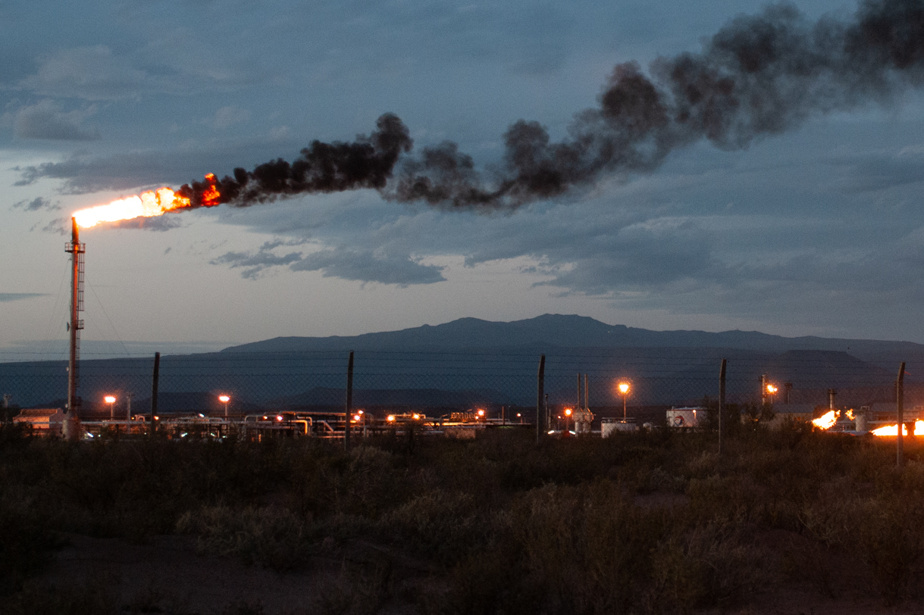(Neuquén) Argentinian Patagonia is full of shale gas and, since the war in Ukraine, production has exploded. Argentina is seeking to position itself as a global energy player, with the help of Canadians.
On the large arid expanses of northern Patagonia, these steppes where the wind blows and the heat cracks the ground, derricks are sprouting up like mushrooms. They pump the hydrocarbons locked in the rocks of Vaca Muerta, a territory of 30,000 km2the second largest shale gas deposit in the world.
A few kilometers from one of the most exploited areas – Fortín de Piedra – the indigenous community of the Mapuche people of Campo Maripe is desperate in the face of accelerated extraction.

PHOTO MARION ESNAULT, SPECIAL COLLABORATION
Luis, a lonko (supreme Mapuche authority), has been struggling for years to obtain the title deeds of its ancestral lands, where the extractive companies come to operate, without consulting them.
“We have to stop the fracking. It’s the worst thing that’s happened to us,” Luis laments.
This lonko (supreme Mapuche authority) has been struggling for years to obtain the title deeds of its ancestral lands, where the extractive companies come to operate, without consulting them. “They crack everything underground. It’s a disaster. Fracking must be banned in Argentina, as in Europe. »
The consequences of fracking ignored

PHOTO MARION ESNAULT, SPECIAL COLLABORATION
Trucks transport the water, sand and chemicals needed for hydraulic fracturing.
In front of the parade of trucks transporting the water, sand and chemicals needed for fracturing – the controversial technique for extracting shale gas – geographer Javier Grosso (University of Comahue, Neuquén) explains to us “that before to pump shale gas, you have to fracture the underground rocks that hold it.

PHOTO AGUSTIN MARCARIAN, REUTERS ARCHIVES
Drilling rig in Vaca Muerte, Argentina
“Wells of four to five kilometers are dug. Then+ it is necessary to inject at very high pressure (between 13,000 and 14,000 pounds-force) 100 million liters of water and 15,000 tons of sand. Accumulated in the basements, this pressure needs to be released and causes… earthquakes”.
In the community of Campo Maripe, as in the surrounding villages, earthquakes have become a daily occurrence. Since 2015, more than 350 earthquakes have been recorded in Vaca Muerta.
The houses are cracking. Some collapsed, like that of Mabel, in Sauzal Bonito. At 65, she mourns “the family home where the children grew up” and hopes that the new house installed by the authorities “will be more resistant to tremors”.

PHOTO MARION ESNAULT, SPECIAL COLLABORATION
Mabel’s home in Sauzal Bonito collapsed following an earthquake caused by fracking.
For her part, the Secretary of Energy, Flavia Royón, denies scientific studies, such as the one published in Nature by Javier Grosso and his colleagues. She declares to have “the proofs that there is no environmental damage” and considers that “Vaca Muerta is one of the development strategies to solve the economic difficulties”, while the country is close to 100% inflation.
Martín Álvarez, coordinator of the NGO Observatorio Petrolero Sur, regrets that the consequences have been passed over in silence.

PHOTO MARION ESNAULT, SPECIAL COLLABORATION
Martín Álvarez, coordinator of the NGO Observatorio Petrolero Sur
Since the war in Ukraine, gas pipelines have been operating 24 hours a day. Thirteen wells are fractured per day, on average. And we count between five and six environmental incidents a day: oil or gas leaks, water contamination, etc.
Martín Álvarez, coordinator of the NGO Observatorio Petrolero Sur
The rush for American and Canadian shale gas
Facing one of the hydrocarbon processing plants installed on the Patagonian steppes, Martin Alvarez says that “with the war in Ukraine, the whole European market opened up, and Vaca Muerta represents an opportunity to cover part of this market “.
Before the invasion of Ukraine in February 2022, around 40% of the gas consumed in Europe came from Russia. At the end of 2022, it was less than 15%. The Old Continent had to knock on other doors to ensure its supply: Norway, Algeria, Qatar, Nigeria… but also the United States, and more recently Canada and Argentina.

PHOTO AGUSTIN MARCARIAN, REUTERS ARCHIVES
Pumps used for shale gas extraction in the province of Neuquén, Argentina
Canada, the second largest producer of shale gas (behind the United States), is seeking to gradually increase its production to reach 30% of the total gas produced in 2040. Argentina, a new player, wants to draw on the experience of its North American partner to develop its model. The two nations have multiplied meetings: in June 2022, an Argentine delegation traveled to Alberta.
In February 2023, in the opposite direction, the Argentine Canadian Chamber of Commerce organized the visit of a dozen Canadian companies to Vaca Muerta.

PHOTO CALLAGHAN O’HARE, REUTERS ARCHIVES
Flavia Royón, Energy Secretary of Argentina
In March, it was the Secretary of Energy, Flavia Royón, who came to the mining summit (PDAC 2023) in Toronto. She sought to convince investors by estimating that, “in a few years, the country will have surpluses of 8 billion dollars thanks to the production planned for Vaca Muerta”. In 2023, a jump of 26% is envisaged in investments.
Martín Álvarez is much more cautious about the future. “Everything is very volatile, and the market is unpredictable. In August 2022, the price of gas exploded and favored investments in Argentina. At the beginning of 2023, the wholesale price of gas fell considerably in Europe. What consequences for Vaca Muerta? The future will tell. »
Climate, war in Ukraine and fossils… everything is linked
In March, the sixth report of the IPCC reiterated that no new fossil energy project should see the light of day to limit climate change. During her presentation, the Ukrainian climatologist Svitlana Krakovska spoke from Kyiv, where the sirens punctuated her speech: “Climate change and the war against Ukraine have the same origin: our dependence on fossil fuels. […] If we don’t address these causes, humanity as a whole is headed for its own downfall. »
